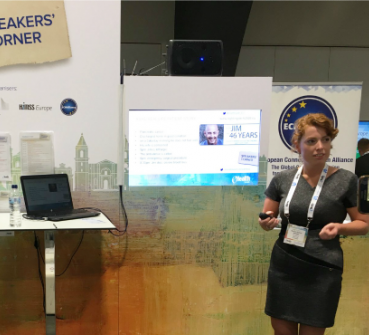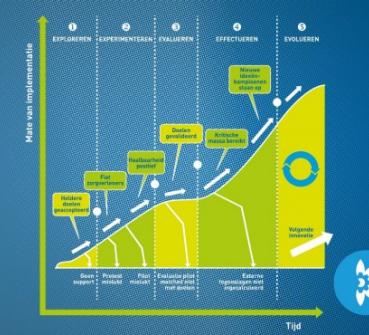Day 4 in Silicon Valley, 2015: The future of healthcare is something we will create ourselves!
Today was the last day of an impressive trip during which we have learned a lot about the American system, about the Netherlands, and about the promises and opportunities provided by technology in healthcare.
Today we visited one of the biggest incubators with a special Health Accelerator Program, and we took a look at the innovation at UCSF Medical Center and a large group of Primary Care Physicians.
A company doesn't start with a customer, but with an investor
Yesterday's last appointment (see: previous blog) tied in perfectly with today's visit to one of San Francisco's biggest incubators. Yesterday, near Google's headquarters, we visited one of the biggest law firms involved in helping startups and investors to realize their dreams. It soon became clear that the process is very different to how we do things in the Netherlands. As an entrepreneur, I once started with an idea, a plan, and then went in search of my own first customers. By working hard and not having to earn anything when I started out, I gradually built up my own startup, which developed into what FocusCura is today.
A traditional approach like that won't get you much praise in Silicon Valley. You have to think big here. You start with an idea and then look for investors, preferably those who want to invest as much money in your company as possible – even if the company isn't actually doing anything yet, apart from safeguarding an enthusiastic idea. Once you have completed your first round of financing, rather than taking a cautious approach to using this money to build on your idea, you realize your idea as quickly as possible and go in search of good people. I understand that you need a substantial amount of money for this, especially considering the fact that a junior project managers earns around $150,000 dollars per year here…
Spray and Pray
The large number of enterprising people in Silicon Valley combined with the amount of money earned through successful businesses results in a very unusual combination. We saw the result of such a combination when we visited one of the biggest incubators in Silicon Valley, a large building in the middle of San Francisco, in which dozens of startups are working on bringing their ideas to life. The concept is that you start with an idea and develop it to a certain extent (often borrowing money from family and friends, and investing a huge amount of your own time). You then find an investor who wants to put money into your business, which often results in $250,000 to $500,000 in seed capital. About 5 to 10 percent of companies go on to the next round in which they obtain their series A financing (amounting to $5-10 million). You then proceed to series B (up to approx. $25 million), series C (up to approx. $50 million), and series D (up to more than $100 million) until you reach the holy grain: the IPO (i.e. stock market launch).
In total, over $1 billion was invested in startups in 2014 in San Francisco alone. This different mentality and completely different way of working generates an incredible amount of energy, and you see everyone working as hard as they can in the incubator to make their dreams come true. "This different mentality and completely different way of working generates an incredible amount of energy" At the same time, there is a big risk that these startups do not come into contact with real customers or develop a revenue model until very late in the game. That's why this strategy is sometimes referred to as Spray and Pray: investors put money into many startups in the hope of finding the right company, which will become the new Uber, Facebook or Apple.
Validation
In response to these developments, we met with people from the University of California, San Francisco (UCSF) Medical Center. They have had a Digital Health partner program in which they work closely with businesses for over ten years. In the last two to three years, they have also created places for startups to work with UCSF researchers on the validation of ideas. New products are developed and marketed in close co-creation, and not without success. More than 90 companies have already been established in this way, over 40 of which are startups that sprouted up directly from the hospital.
As a result of this close cooperation, ideas are validated sooner, with many pilot projects carried out in a sandbox environment (i.e. separated from the rest). A whole innovation accelerator program has been developed for this, which, for successful innovations, can be scaled up to the hospital's nearly 15 million patients and a partner network with 17 hospitals in the United States.
Influencing the world around you as a patient
Many innovations are based on the idea that you do not simply suffer your fate as a patient. But not only that, the architecture in the medical center is based on the same concept. As you walk into the children's hospital, there is a huge video wall where children are recognized immediately through kinect motion sensing technology and depicted on the big wall. They can send the videos to themselves or share them with others. This literally illustrates the fact that UCSF looks at the whole person (instead of a silo of a disorder or disease) and that patients can influence their environment themselves.
We also talked about the possibilities of influencing the world for patients through our applications and concepts. The integrated approach to both medical care (PatientHub virtual waiting room) and the social approach (our HomeBingo and collaboration with senior citizens' association Unie KBO) in particular captured the imagination. In combination with our cVitals extension for the AppleWatch for support of certain clinical pictures, this could lead to some interesting, innovative solutions. We were therefore very happy to agree to look into a number of specific options together.
Primary care: a membership
Before concluding our experiences in Silicon Valley for this trip, we took a look at primary care. As I wrote in my first blog, this is organized and financed very differently here than in the Netherlands. A model involving virtual care can be found through organizations that you can join. You choose the right HealthPlan for you (ranging from 'bronze' with limited options to 'gold' with many options), which more or less guarantees you access to primary care. This is an area in which improvements are being made in chronic care, and virtual care like that provided through our PatientHub can play an important role.
The American Dream
Tired from all of the experiences and happy to have learned a lot, we are slowly nearing the end to our flying visit to San Francisco and Silicon Valley. I am very satisfied with the new technology we will take back to the Netherlands with us, and with concrete possibilities and ideas for pilots involving our innovations in home care, hospital care and primary care. "We may not have the billions in the Netherlands, but we certainly have the passion and the creativity" Satisfied because I have seen that innovation in care can provide may opportunities for patients, and that in certain areas the American way of working is actually very result and target oriented. And I am also satisfied because we have a unique position in the Netherlands, in terms of how our healthcare is organized, the excellent access to care for anyone no matter what their income, and also our capacity for innovation. We may not have the billions in the Netherlands, but we certainly have the passion and the creativity. So let's focus on that and make sure that we apply our Dutch business mentality. After all, we are the architects of the future of our healthcare system!
Trying out innovations…
So as not to stick to blogging alone, but to share experiences with everyone involved in this area of healthcare innovation and sample the enthusiasm for our own Dutch concepts, such as our applications at FocusCura using Blended HomeCare with our cContact/CompanionApp and the Mobile Clinic (PatientHub/cVitals App), we are organizing the first Healthcare Innovation Congrestival for our partners on June 9, 2015. Here we will look towards the future of healthcare with our partners and, most importantly, visitors can try out this future themselves in the various Congrestival tents with themes like Virtual Reality and the future of Video Care, video consultations through a doctor in your pocket to home monitoring and Big Data. Please let us know if you would like to attend. Because, although we can certainly learn from Silicon Valley when it comes to creating the future of care, we have no need to be modest in the Netherlands. Let's simply achieve healthcare innovation, together, in the interest of all patients!
This last blog concludes a week in Silicon Valley. I would like to thank Thijs Boekhoff's Healthcare Innovation Transfer for providing professional support to us as Dutch businesspeople in our quest in the Valley.
This blog was previously published on Skipr.nl.


